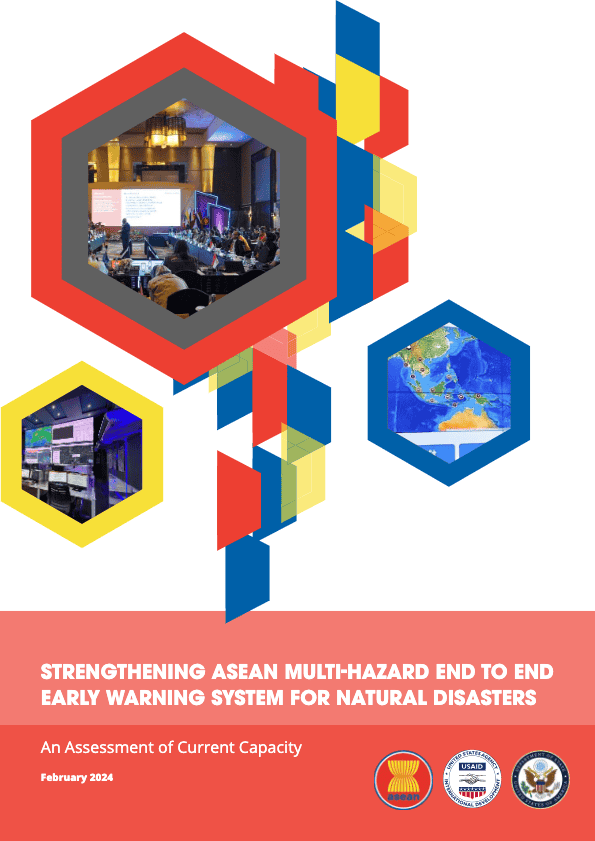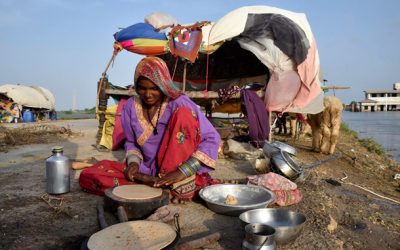Jakarta, Indonesia—The Pacific Disaster Center (PDC) and the ASEAN Coordinating Centre for Humanitarian Assistance on Disaster Management (AHA Centre) recently announced the renewal of their long-held partnership through a new Memorandum of Intent (MOI) to enhance disaster risk reduction and humanitarian assistance throughout the ASEAN region. The MOI was announced only one week after PDC and ASEAN officially released the results of an ASEAN End-to-End Early Warning System for Natural Hazards Assessment conducted in partnership with USAID.
During his visit to Jakarta on April 30, 2024, PDC’s Executive Director Ray Shirkhodai met with Mr. Lee Yam Ming, Executive Director of the AHA Centre to discuss details of the new MOI which aims to expand collaboration between the two centers on risk analysis and multi-hazard impact assessments, early warning capacity development, and coordination of disaster preparedness initiatives.
“We are honored to continue our successful and longstanding partnership with the AHA Centre. Our work with ASEAN spans more than two decades and we’ve celebrated numerous successes with the AHA Centre since it was first initiated as a regional hub for disaster risk reduction nearly fifteen years ago.
Through our collaboration with experts at the AHA Centre, the first regional multi-hazard early warning and risk intelligence platform known as the Disaster Monitoring and Response System, or DMRS, was launched in 2012 to serve all ASEAN Member States. Today, DMRS provides near-real-time impact analysis advanced analytics, insights, and actionable information, for a multitude of hazards, empowering decision-makers to understand risks and quickly mobilize life-saving humanitarian resources.”
—PDC Executive Director Ray Shirkhodai
 DMRS is powered by PDC’s DisasterAWARE technology and was launched as a collaborative effort between PDC and the AHA Centre in 2012. PDC and the AHA Centre have since collaborated on disaster risk assessments and exercise engagements over the years, including ARDEX, ADMM-Plus, and national-level exercises and have continuously enhanced DMRS to bolster the readiness and resilience of Member States.
DMRS is powered by PDC’s DisasterAWARE technology and was launched as a collaborative effort between PDC and the AHA Centre in 2012. PDC and the AHA Centre have since collaborated on disaster risk assessments and exercise engagements over the years, including ARDEX, ADMM-Plus, and national-level exercises and have continuously enhanced DMRS to bolster the readiness and resilience of Member States.
“The AHA Centre is mandated to facilitate the coordination of disaster management among ASEAN Member States, providing early warning and impact analysis through DMRS, as well as training and capacity development. The work we’ve done with PDC over the years to enhance DMRS, as well as their expertise in risk assessment and predictive analytics has been integral to our operations and to the overall disaster risk reduction objectives of the region.”
—AHA Centre Executive Director Mr. Lee Yam Ming
Mr. Lee Yam Ming pointed to recent case studies in which the AHA Centre’s use of DMRS and PDC analytics was vital to life-saving operations including the recent response to Tropical Cyclone Mocha (a Category 5-equivalent storm) to several ASEAN Member States in 2023.

Shrikhodai shared Mr. Lee Yam Ming’s sentiment about the importance of the partnership, stating, “Our future endeavors will create an even safer ASEAN region and will help nations build resilience to the rapidly changing landscape of hazard impacts by ensuring decision makers have access to the best science, risk analytics, and early warnings for all.”







